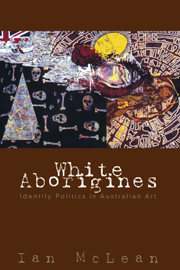Book contents
- Frontmatter
- Contents
- List of Illustrations
- Preface
- Acknowledgments
- 1 Ocean and the Antipodes
- 2 Artful Killings
- 3 The Art of Settlement
- 4 The Bad Conscience of Impressionism
- 5 Aboriginalism and Australian Nationalism
- 6 The Aboriginal Renaissance
- 7 Aboriginality and Contemporary Australian Painting
- 8 Painting for a New Republic
- Postscript: The Wandering Islands
- Notes
- Bibliography
- Index
8 - Painting for a New Republic
Published online by Cambridge University Press: 05 August 2012
- Frontmatter
- Contents
- List of Illustrations
- Preface
- Acknowledgments
- 1 Ocean and the Antipodes
- 2 Artful Killings
- 3 The Art of Settlement
- 4 The Bad Conscience of Impressionism
- 5 Aboriginalism and Australian Nationalism
- 6 The Aboriginal Renaissance
- 7 Aboriginality and Contemporary Australian Painting
- 8 Painting for a New Republic
- Postscript: The Wandering Islands
- Notes
- Bibliography
- Index
Summary
Australia is still a colonial culture because it remains two worlds: Aboriginal and non-Aboriginal. The accumulating generations of non-Aboriginal native-born Australians and the recent refigurings of multiculturalism have not altered this. Nor has the ever-increasing hetero-geneity of each sphere. The policies and institutions of government, the rhetoric of officials on both sides and the more general structures of everyday life – for example, the way Australian art is bought, sold, exhibited, taught and written about – are evidence of Australia being a split economy. However, while this two-nation paradigm (henceforth called the colonial paradigm) is still dominant, it is no longer secure. Increasingly, the focus of national affairs is on reconciliation. The most interesting and difficult questions being asked today are not what goes on in the separate realms of Aboriginal and non-Aboriginal economies, but what happens between them.
If most Australians still do find a place for themselves in the colonial paradigm, an increasing number cannot. While many have always fallen between the Aboriginal and non-Aboriginal spheres, they were quickly pushed by the paradigmatic power of the binary into one or the other. This does not happen so readily these days. Gordon Bennett, for example, does not easily find a place in either Aboriginal or non-Aboriginal Australia. In finding a way of being between the two, he exceeds the binary logic of the colonial paradigm.
Growing up in the suburbs as a white Australian, the discovery at about the age of eleven of his Aboriginal heritage was a shock from which Bennett never fully recovered.
- Type
- Chapter
- Information
- White AboriginesIdentity Politics in Australian Art, pp. 134 - 148Publisher: Cambridge University PressPrint publication year: 1998

